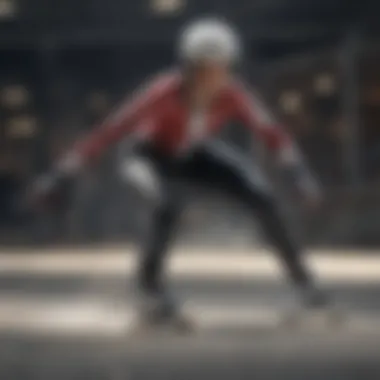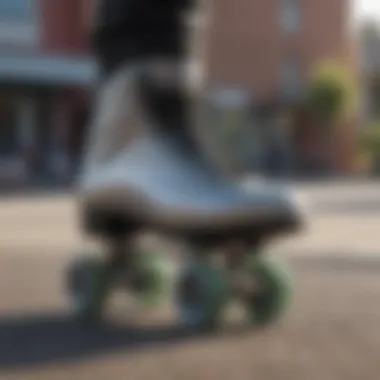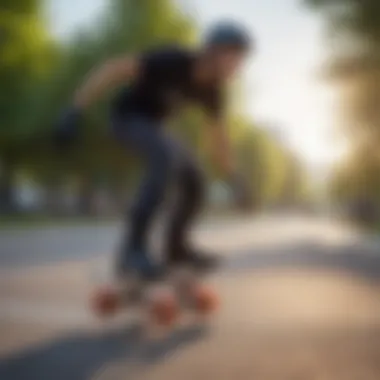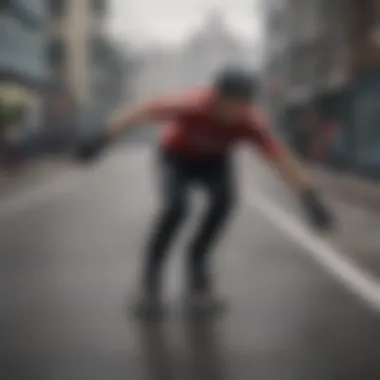Master the Art of Inline Skates Slalom with This Comprehensive Guide


Skateboarding News Updates
Inline skates slalom is an exhilarating sport that requires precision and skill. Whether you're a novice or a seasoned skater, staying updated on the latest news and events in the skating world is crucial. From competitions showcasing top talent to new product launches revolutionizing the industry, keeping tabs on skateboarding news can provide valuable insights and inspiration for your inline skates slalom journey.
Trick Tutorials and Guides
Mastering inline skates slalom involves a repertoire of tricks that range from fundamental to expert level. Beginners can start with basic trick breakdowns that focus on balance and form, while advanced skaters can elevate their skills with intricate maneuver tips. Exploring freestyle and street skate techniques adds versatility to your slalom style, allowing you to navigate various terrains with finesse and creativity.
Skateboarding Culture and Lifestyle
Immersing yourself in the skateboarding culture extends beyond honing your skills on wheels. Discover notable influencers who are shaping the skating scene with their innovative approaches and unique styles. Explore diverse skatepark reviews to find the perfect spot for your practice sessions and stay updated on the latest fashion trends in skateboarding to amp up your gear game with style and functionality.
Gear Reviews and Recommendations
Choosing the right equipment is paramount in improving your inline skates slalom performance. Dive into skateboard deck reviews to find the ideal deck shape and size that suits your riding preferences. Compare different truck and wheel options to enhance your maneuverability and speed on the pavement. Don't forget to explore protective gear suggestions to prioritize safety and prevent injuries during your slalom sessions.
Healthy Lifestyle for Skaters
Maintaining a healthy lifestyle is essential for optimizing your inline skates slalom proficiency. Engage in injury prevention exercises to condition your body and minimize the risk of strains and sprains while skating. Incorporate skateboard fitness and strength training into your routine to build endurance and power for longer and more dynamic slalom runs. Fuel your body with proper nutrition tailored for skaters, supporting your energy levels and recovery for peak performance on your inline skates.
Introduction
Inline skating slalom, a thrilling and challenging activity, holds a paramount position in the realm of extreme sports. This comprehensive guide immerses you into the intricate world of mastering inline skates slalom. Whether you are a novice seeking to embark on this exhilarating journey or an adept skater looking to elevate your skills, this guide is your one-stop destination for all things slalom. The allure of inline skates slalom lies in its dynamic blend of agility, precision, and artistic expression, making it a favored discipline among skateboarders and extreme athletes alike. By delving into the nuances of slalom skating, you can unlock a myriad of opportunities for personal growth and unparalleled excitement.
Understanding Inline Skates Slalom
What is Inline Skates Slalom?
Inline skates slalom, a mesmerizing fusion of speed and skill, entails navigating a series of strategically placed cones with finesse and dexterity. This discipline demands not only physical prowess but also mental acuity, as skaters weave through obstacles with precision and fluidity. The core essence of inline skates slalom rests in the harmonious coordination of body movements, footwork, and spatial awareness, culminating in a visually captivating performance. Embracing the essence of control and grace, slalom skaters indulge in a symphony of motion that captivates onlookers and fellow enthusiasts alike. The appeal of inline skates slalom lies in its ability to test one's limits while fostering a deep sense of accomplishment and self-mastery.
History of Inline Skates Slalom
Tracing its roots back to the vibrant skate culture of the 1980s, inline skates slalom has evolved from a niche pastime to a globally recognized sport. The history of inline skates slalom is a tapestry woven with the threads of innovation, creativity, and unyielding passion for skating. As skaters across the globe sought to push the boundaries of what was possible on wheels, slalom skating emerged as a testament to human ingenuity and perseverance. From its humble beginnings in urban skate parks to the grand stages of international competitions, the journey of inline skates slalom is a testament to the indomitable spirit of those who dare to defy convention. Embracing tradition while embracing innovation, slalom skaters continue to pay homage to the pioneers of the sport while paving the way for future generations of skaters to soar to greater heights.
Equipment
In the realm of inline skates slalom, equipment plays a crucial role in facilitating optimum performance and safety. Ensuring you have the right gear can make a significant impact on your slaloming experience. The type of inline skates you choose and the features they offer are paramount considerations that can enhance your agility, speed, and control while maneuvering through the slalom course.


Choosing the Right Inline Skates
When it comes to selecting inline skates for slaloming, understanding the different types available is essential. Each type of inline skate serves a specific purpose and caters to varying skill levels. For instance, freestyle skates are ideal for advanced slalom techniques, offering increased maneuverability and flexibility. On the other hand, slalom skates are more stability-oriented, suitable for beginners looking to build confidence in their movements.
Types of Inline Skates
Freestyle skates are renowned for their lightweight construction and responsive design, allowing skaters to perform intricate maneuvers with precision and style. These skates are favored by experienced slalomers for their adaptability to complex footwork and quick transitions between tricks. On the contrary, slalom skates prioritize stability and control, featuring a sturdier frame and wheels that optimize balance and support during slalom runs.
Features to Look for in Inline Skates
When searching for the perfect pair of inline skates for slaloming, several key features warrant consideration. The rollerblade's wheel size, hardness, and arrangement significantly impact speed and agility on the slalom course. Additionally, the boot's ankle support, ventilation, and fit are crucial for comfort and performance. Choosing inline skates with adjustable elements allows for customization to match your skill level and skating preferences with precision.
Essential Gear for Slaloming
Apart from inline skates, incorporating essential gear is vital for a safe and productive slaloming session. Protective gear shields you from potential injuries, ensuring you can practice without compromising safety. Moreover, selecting the right clothing and accessories not only enhances your performance but also adds a touch of style to your slaloming endeavors.
Protective Gear
Protective gear such as helmets, knee pads, elbow pads, wrist guards, and gloves offer vital protection against falls and collisions during slalom practice. Prioritizing high-quality protective equipment that fits securely and comfortably is paramount to minimizing the risk of injuries while executing challenging slalom maneuvers.
Clothing and Accessories
In the realm of slaloming, choosing appropriate clothing and accessories can elevate both your comfort and style quotient. Breathable and moisture-wicking fabrics are advantageous, as they keep you cool and dry throughout your practice session. Furthermore, accessories like sunglasses, gloves, and hats not only offer sun protection but also contribute to a polished and cohesive slaloming ensemble.
Techniques
In this section of the article, we delve into the crucial aspect of techniques in mastering inline skates slalom. Techniques are the foundation upon which skilled slalomers build their prowess. Understanding and implementing proper techniques can significantly enhance one's performance and fluidity on skates. By focusing on specific elements such as body positioning, footwork, and efficiency of movement, individuals can progress from novice to expert level. Moreover, mastering techniques not only improves the aesthetic appeal of slalom routines but also plays a vital role in optimizing speed and agility, essential for competitive slaloming. Through a comprehensive exploration of various techniques, skaters can refine their skills and elevate their performance to new heights.
Basic Slalom Maneuvers
Cone Weaving:
Cone weaving, a fundamental maneuver in slalom skating, involves precision and control as skaters navigate through a series of cones placed in a zigzag pattern. This technique tests skaters' agility and maneuverability, requiring swift directional changes while maintaining balance and speed. The key characteristic of cone weaving lies in its ability to enhance skaters' spatial awareness and coordination. Practicing cone weaving helps skaters develop sharp turns and quick transitions, essential for executing complex slalom routines efficiently. While cone weaving poses challenges in terms of precision and timing, mastering this maneuver enhances overall slalom skillset and paves the way for tackling advanced routines.
Crossovers:
Crossovers are dynamic movements where skaters crisscross their legs while maintaining forward momentum, aiding in tight turns and fluid transitions between cones. The key characteristic of crossovers lies in their capacity to improve skaters' turning radius and speed control. By utilizing crossovers strategically, skaters achieve smoother and more efficient navigation through challenging slalom courses. This technique requires coordination and balance, as skaters must synchronize leg movements seamlessly to maintain momentum and rhythm. While crossovers enhance agility and footwork, mastering this maneuver empowers skaters to tackle intricate slalom patterns with finesse.
Parallel Turns:


Parallel turns involve smoothly transitioning from one edge of the skate to the other while maintaining continuous forward motion. The key characteristic of parallel turns is their contribution to skaters' control and stability during directional changes. By executing parallel turns effectively, skaters can navigate corners and curves with precision and fluidity. This technique enhances skaters' ability to maintain speed while maneuvering through complex slalom setups. While mastering parallel turns requires practice and finesse, it serves as a foundational skill that underpins more advanced slalom maneuvers.
Advanced Techniques
In the realm of advanced slalom techniques, skaters unlock new levels of intricacy and skill mastery, pushing the boundaries of their capabilities to create stunning routines.
Backward Slalom:
Backward slalom elevates the complexity of slaloming by requiring skaters to perform maneuvers in reverse, showcasing exceptional balance and coordination. The key characteristic of backward slalom is its demand for spatial awareness and adaptability, as skaters navigate through cones with reversed body orientation. Mastering backward slalom enhances skaters' overall control and versatility on skates, opening up avenues for creative and challenging routines that captivate audiences.
Speed Control:
Speed control is a vital aspect of advanced slalom techniques, enabling skaters to modulate their velocity with precision and efficiency. The key characteristic of speed control lies in its impact on skaters' performance quality, as maintaining optimal speed throughout routines is essential for achieving seamless transitions and executing complex maneuvers flawlessly. By honing speed control skills, skaters enhance their ability to adjust pace according to course requirements, showcasing grace and control in their slalom performances.
Combination Moves:
Combination moves entail the integration of multiple slalom techniques into fluid sequences, creating dynamic and visually engaging routines. The key characteristic of combination moves is their versatility and creativity, allowing skaters to showcase a diverse range of skills in a seamless flow. By mastering combination moves, skaters can elevate their performances by incorporating transitions, spins, and intricate footwork patterns. This technique adds depth and complexity to slalom routines, captivates audiences, and distinguishes skilled slalomers from their peers.
Training
In the realm of mastering inline skates slalom, training assumes a critical role. It serves as the foundation upon which skaters build their skills and enhance their agility. Training encompasses a plethora of elements vital for honing one's slaloming abilities, from basic techniques to advanced maneuvers and drills. Without a structured training regimen, skaters may struggle to progress effectively in this dynamic sport, making it imperative to dedicate time and effort to training.
Developing Skills and Agility
- Balance Exercises: Balance exercises stand out as a fundamental component in the journey of mastering inline skates slalom. These exercises target proprioception and core strength, essential for maintaining stability and control while maneuvering through intricate slalom patterns. Skaters benefit greatly from balance exercises due to their capacity to enhance agility and preempt falls by improving coordination and postural control. The unique feature of balance exercises lies in their ability to simulate the uneven weight distribution experienced during slaloming, thereby better preparing skaters for the challenges on the course.
- Footwork Drills: Integral to skill development in slalom skating, footwork drills play a pivotal role in refining technique and agility. By focusing on precise foot placement and fluid transitions between maneuvers, footwork drills help skaters navigate the course with efficiency and grace. Skaters appreciate footwork drills for their capacity to improve rhythm, timing, and overall coordination, thereby boosting performance. A notable aspect of footwork drills is their adaptability, allowing skaters to tailor drills to target specific areas for improvement and progressively challenge their abilities.
Creating a Training Routine
- Setting Goals: Setting clear, achievable goals is a cornerstone of effective training in inline skates slalom. By establishing specific objectives for skill enhancement and progress, skaters can chart a course for improvement and track their performance over time. Goals serve as motivators, guiding skaters towards continuous development and pushing their boundaries in pursuit of mastery. The unique feature of setting goals is the clarity they provide, offering skaters tangible benchmarks to strive towards and celebrate upon achievement.
- Progress Tracking: An indispensable aspect of any training regimen, progress tracking allows skaters to monitor their advancement and adjust their approach accordingly. By systematically recording performance metrics, such as completion times, accuracy in maneuvers, and endurance levels, skaters gain valuable insights into their strengths and areas needing development. Progress tracking facilitates accountability and reflection, enabling skaters to fine-tune their training routines for optimal growth. The advantage of progress tracking lies in its ability to provide a comprehensive overview of skaters' evolution, fostering continuous improvement and refinement in skill attainment.
Competition and Events
In the realm of mastering inline skates slalom, the aspect of competitions and events plays a pivotal role in shaping a skater's skills and experiences. Engaging in competitions not only provides a platform for showcasing one's prowess but also fosters camaraderie amongst fellow skaters. By participating in slalom competitions, skaters can benchmark their progress, gain valuable feedback from judges, and push themselves to achieve new heights in their slaloming journey. These events serve as a melting pot of talent and innovation, where skaters can observe and learn from each other, leading to a continuous evolution of techniques and strategies in the sport. Furthermore, competitions and events offer a thrilling and adrenaline-pumping atmosphere that ignites the competitive spirit within skaters, driving them to perform at their best and strive for excellence in every run.
Participating in Slalom Competitions
Rules and Regulations
When delving into the world of slalom competitions, understanding the intricacies of rules and regulations is quintessential for skaters aiming to compete at their best. These guidelines set the framework for fair play, ensuring that all participants adhere to a standardized set of rules to maintain a level playing field. Rules and regulations outline the conduct expected from skaters, the scoring criteria employed by judges, as well as safety protocols to protect the well-being of all contenders. By familiarizing themselves with these regulations, skaters can navigate competitions confidently, knowing what is expected of them and how they will be evaluated. The transparency and consistency provided by rules and regulations are crucial in ensuring the integrity and legitimacy of slalom competitions, reassuring skaters that their performances are assessed fairly and objectively.


Preparing for Competition
Preparation is key when gearing up for a slalom competition, and skaters must pay close attention to various facets to maximize their performance on the big day. From honing their technical skills through rigorous practice sessions to fine-tuning their equipment for optimal functionality, every detail counts in preparing for competition. Skaters must also focus on mental preparation, cultivating a mindset of focus, determination, and resilience to tackle the challenges that competitions may present. Additionally, strategizing and visualizing their runs can help skaters anticipate obstacles and plan their maneuvers effectively, giving them a competitive edge on the slalom course. By dedicating time and effort to thorough preparation, skaters can enter competitions feeling confident, prepared, and ready to showcase their slaloming prowess to the best of their abilities.
Community and Resources
Community and resources play a pivotal role in the realm of mastering inline skates slalom. Whether you are a novice seeking guidance or a seasoned skater looking to connect with like-minded individuals, the community aspect fosters a sense of camaraderie and shared passion. By tapping into various resources, individuals can access valuable information, tips, and insights that can propel their slaloming skills to new heights. Embracing the community and utilizing resources not only provides support but also inspires continuous growth and learning in this dynamic sport.
Online Forums and Communities
Connecting with Fellow Skaters
Connecting with fellow skaters through online forums and communities is a game-changer in the world of inline skates slalom. This interaction allows skaters to exchange experiences, seek advice, and forge meaningful connections with individuals who share a common interest. The key characteristic of connecting with fellow skaters lies in the exchange of knowledge and tricks, which contributes significantly to skill development and overall improvement. This avenue serves as a beneficial platform for skaters to enhance their techniques, troubleshoot challenges, and stay motivated on their slaloming journey. The unique feature of connecting with fellow skaters is the real-time feedback and sense of community it offers, although potential downsides may include information overload or differing skill levels among participants.
Sharing Tips and Tricks
Sharing tips and tricks within online forums and communities is a valuable practice for enthusiasts of inline skates slalom. This aspect contributes immensely to the collective knowledge base, enabling skaters to learn new maneuvers, refine existing skills, and explore innovative approaches to slaloming. The key characteristic of sharing tips and tricks lies in the mutual exchange of expertise and insights, fostering a culture of continuous learning and growth within the slaloming community. This practice is a popular choice for individuals looking to expand their repertoire of techniques, troubleshoot common issues, and stay updated on the latest trends. The unique feature of sharing tips and tricks is the collaborative nature of skill-sharing, although challenges may include varying levels of detail or compatibility with individual styles.
Training Facilities and Schools
Finding Local Training Centers
Locating local training centers holds significant importance for anyone passionate about mastering inline skates slalom. These hubs serve as invaluable spaces where skaters can receive hands-on instruction, access specialized equipment, and engage in structured training tailored to their skill levels. The key characteristic of finding local training centers is the personalized guidance and immediate feedback provided by experienced instructors, enriching the learning experience and accelerating skill development. This option is a popular choice among enthusiasts seeking to refine their techniques, overcome specific challenges, and progress systematically in their slaloming journey. The unique feature of finding local training centers is the immersive learning environment they offer; however, drawbacks may include limited availability or distance from one's location.
Enrolling in Slalom Classes
Enrolling in slalom classes is a strategic move for individuals committed to honing their inline skates slalom abilities. This structured approach to learning encompasses specialized instruction, progressive skills training, and ongoing support from knowledgeable coaches. The key characteristic of enrolling in slalom classes is the comprehensive curriculum designed to cover fundamental to advanced techniques, fostering a well-rounded skill set and enhancing overall performance. This choice is beneficial for skaters looking to delve deep into the intricacies of slaloming, refine their form, and receive expert guidance on technique enhancement. The unique feature of enrolling in slalom classes is the structured progression and personalized attention provided, although potential disadvantages may include scheduling conflicts or varying teaching styles.
Conclusion
In the realm of mastering inline skates slalom, the conclusion acts as the pivotal moment where all the knowledge imparted throughout the article culminates. It serves as the beacon guiding enthusiasts towards refining their slaloming skills to perfection. The significance of this conclusive section lies in its ability to encapsulate the essence of slalom skating, unveiling the path to expertise. By delving deep into the crevices of advanced techniques and refining fundamental skills, learners can grasp the true artistry of inline skates slalom. Through consistent practice and dedication, skaters can elevate their proficiency and carve their unique style on the slalom course.
Mastering the Art of Inline Skates Slalom
Summary of Key Points
Embarking on the journey of mastering inline skates slalom necessitates a keen understanding of the key points elaborated in the preceding sections. These critical junctures serve as the compass for enthusiasts navigating the intricate terrain of slalom skating. Embracing the nuances of cone weaving, crossovers, and parallel turns fosters a solid foundation for a skater's advancement in the sport. The essence of continuous learning and skill refinement underscores the significance of each key point discussed, shaping a skater's trajectory towards excellence in slalom skating.
The distinctive attribute of summarizing key points lies in its ability to distill complex techniques and maneuvers into digestible chunks of knowledge. This approach enables skaters to assimilate information efficiently, enhancing their learning curve and accelerating their progress in mastering inline skates slalom. The strategic incorporation of summary key points not only reinforces learning but also fosters a holistic understanding of the intricacies involved, equipping skaters with the arsenal needed to conquer the slalom course.
Continued Practice and Improvement
Delving into the realm of continued practice and improvement unveils a crucial facet in the journey of mastering inline skates slalom. The relentless pursuit of excellence through consistent practice resonates deeply with skaters aspiring for perfection in their craft. By cultivating a disciplined training regimen and embodying a growth mindset, enthusiasts can chart a course towards continual improvement and mastery in slalom skating.
Navigating the terrain of continued practice and improvement unveils a myriad of opportunities for skaters to hone their skills and push the boundaries of their capabilities. Embracing challenges and seeking constant refinement empowers skaters to transcend their limitations and unlock their full potential on the slalom course. The synergy between consistent practice and incremental improvement paves the way for skaters to sculpt their unique style, leaving an indelible mark on the realm of inline skates slalom.







